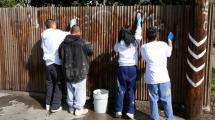Youth who receive special education services under the Individuals with Disabilities Education Act (IDEA 2004) and especially young adults of transition age, should be involved in planning for life after high school as early as possible and no later than age 16. Transition services should stem from the individual youth’s needs and strengths, ensuring that planning takes into account his or her interests, preferences, and desires for the future.
Education/Higher Education
The majority of AI/AN youth, an estimated 93 percent, attend public schools, while approximately seven percent attend Bureau of Indian Affairs (BIA) schools. Additionally, Native students are more likely to attend rural schools.1
AI/AN youth have fewer successful educational outcomes than the general population by nearly all measures. Among AI/AN youth aged 25 and older, 22 percent have not finished high school and only 13 percent have a bachelor’s degree or higher, compared to 29 percent of the U.S. population who have a bachelor’s degree.2
AI/AN youth experience disparities in many aspects of their education. In 2011, only about 16 percent of AI/AN fourth and eighth graders were proficient or advanced in reading and math compared to nearly 45 percent of White fourth and eighth graders, according to the National Assessment of Educational Progress. While all other race/ethnicities saw an improvement in reading and math performance between 2005 and 2011, Native youth did not.3
In higher education, among students enrolled in four-year institutions, only 39 percent of Native students completed college and received their bachelor’s degree compared to 62 percent of White students.4 AI/AN youth also lack access to Advanced Placement (AP) exams, score lower on college entry exams (e.g., ACT), and earn a lower annual median income than others with bachelor’s degree or higher.5
It is evident that there are educational disparities within AI/AN populations, however there are three areas that have been identified as being helpful in improving educational outcomes for Native students. The following three areas include examples of how AI/AN students can be better supported in achieving improved educational outcomes:
- Instructional Practices: Promising instructional practices included increasing local autonomy; actively valuing elders’ knowledge; ensuring harmony between home and community life and education; and employing culturally responsive educational practices.
- Curriculum Content: Curriculums that were found to be engaging for students included content that utilized students’ prior knowledge, experience, and community values; included culturally relevant content across the curriculum; and ensured that content was accurate and did not include bias and stereotypes.
- School Climate: Important attributes of healthy school climate included developing positive behavior supports; building relationships with students and families; communicating a belief in the abilities of learners; learning about Indian heritage; and providing the necessary supports to reach high levels of achievement.6
Resources
AANAPISIs: Serving a Critical AAPI Student Population
This blog outlines the issues discussed at a meeting that former Secretary of Education Arne Duncan held with Asian American, Native Hawaiian, and Pacific Islander education stakeholders.
Investing in the Future: Native American Youth and Education
This Department of Education blog discusses lessons learned from the White House Tribal Nations Conference held on November 13, 2013.
National Indian Education Association
The National Indian Education Association conducts research and provides information on educational opportunities for AI/AN youth.
Status and Trends in the Education of American Indians and Alaska Natives: 2008
Report by the National Center for Education Statistics on current conditions and recent trends in the education of AI/ANs using statistical measures.
Strengthening Tribal Communities through Education and Economic Development
This fact sheet from The White House provides ways the government can improve tribal education opportunities and outcomes for tribal youth.
References
1 The State of Education for Native Students, 2013
2 2014 Native Youth Report, 2014
3 The State of Education for Native Students, 2013
4 2014 Native Youth Report, 2014
5 National Indian Education Association: Statistics on Native Students, 2012
6 Jesse, Northup, & Withington, 2015; Oakes & Maday, 2009
Other Resources on this Topic
Agencies
Announcements
Feature Articles
Programs
Publications
Resources
Youth Topics
Youth Briefs
Research links early leadership with increased self-efficacy and suggests that leadership can help youth to develop decision making and interpersonal skills that support successes in the workforce and adulthood. In addition, young leaders tend to be more involved in their communities, and have lower dropout rates than their peers. Youth leaders also show considerable benefits for their communities, providing valuable insight into the needs and interests of young people
Statistics reflecting the number of youth suffering from mental health, substance abuse, and co-occurring disorders highlight the necessity for schools, families, support staff, and communities to work together to develop targeted, coordinated, and comprehensive transition plans for young people with a history of mental health needs and/or substance abuse.
Nearly 30,000 youth aged out of foster care in Fiscal Year 2009, which represents nine percent of the young people involved in the foster care system that year. This transition can be challenging for youth, especially youth who have grown up in the child welfare system.
Research has demonstrated that as many as one in five children/youth have a diagnosable mental health disorder. Read about how coordination between public service agencies can improve treatment for these youth.
Civic engagement has the potential to empower young adults, increase their self-determination, and give them the skills and self-confidence they need to enter the workforce. Read about one youth’s experience in AmeriCorps National Civilian Community Corps (NCCC).






